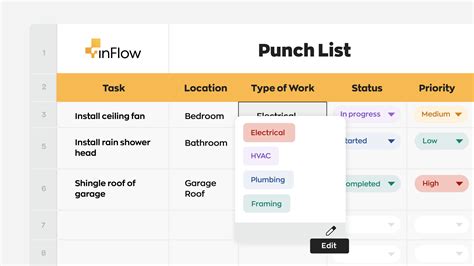As a construction project nears completion, a thorough inspection is necessary to ensure that all aspects of the build meet the required standards. A punch list is a crucial tool used to identify and track any defects, deficiencies, or incomplete work that needs to be addressed before the project can be considered finished. In this article, we will explore the concept of a punch list template for construction projects, its benefits, and how to create and use one effectively.
What is a Punch List Template?
A punch list template is a document used to record and track all the items that need to be corrected or completed before a construction project is considered finished. It is typically created during the final inspection of the project, and it serves as a checklist to ensure that all aspects of the build meet the required standards.
Benefits of Using a Punch List Template
Using a punch list template can bring numerous benefits to a construction project. Some of the advantages include:
- Improved Communication: A punch list template helps to ensure that all stakeholders, including the project manager, contractors, and clients, are on the same page regarding the items that need to be addressed.
- Increased Efficiency: By having a clear and comprehensive list of items to be corrected, contractors can work more efficiently to complete the project.
- Enhanced Quality: A punch list template helps to ensure that all aspects of the build meet the required standards, resulting in a higher-quality finish.
- Reduced Delays: By identifying and addressing issues early on, a punch list template can help to reduce delays and avoid costly rework.
How to Create a Punch List Template
Creating a punch list template is a straightforward process. Here are the steps to follow:
- Identify the Project Requirements: Start by identifying the specific requirements of the project, including the building codes, regulations, and client specifications.
- Conduct a Final Inspection: Conduct a thorough final inspection of the project to identify any defects, deficiencies, or incomplete work.
- Create a List of Items: Create a list of all the items that need to be corrected or completed, including any defects, deficiencies, or incomplete work.
- Assign Responsibilities: Assign responsibilities to each contractor or subcontractor for each item on the list.
- Establish a Timeline: Establish a timeline for completing each item on the list.
What to Include in a Punch List Template
A punch list template should include the following information:
- Project Information: Include the project name, location, and contact information.
- Item Description: Provide a clear and concise description of each item on the list.
- Location: Identify the location of each item on the list.
- Responsibility: Assign responsibility to each contractor or subcontractor for each item on the list.
- Timeline: Establish a timeline for completing each item on the list.
- Status: Track the status of each item on the list, including any progress or completion.
Best Practices for Using a Punch List Template
To get the most out of a punch list template, follow these best practices:
- Use a Standardized Template: Use a standardized template to ensure consistency across all projects.
- Keep it Up-to-Date: Keep the punch list template up-to-date by regularly updating the status of each item on the list.
- Communicate Effectively: Communicate effectively with all stakeholders, including contractors, subcontractors, and clients, to ensure that everyone is on the same page.
- Prioritize Items: Prioritize items on the list based on their importance and urgency.

Tips for Creating an Effective Punch List Template
Here are some tips for creating an effective punch list template:
- Keep it Simple: Keep the template simple and easy to use.
- Use Clear Language: Use clear and concise language to describe each item on the list.
- Include Photos: Include photos or diagrams to help illustrate each item on the list.
- Make it Collaborative: Make the template collaborative by allowing multiple users to access and update it.
Common Mistakes to Avoid
When creating a punch list template, avoid the following common mistakes:
- Not Including Enough Detail: Not including enough detail in the template can lead to confusion and miscommunication.
- Not Keeping it Up-to-Date: Not keeping the template up-to-date can lead to delays and inefficiencies.
- Not Communicating Effectively: Not communicating effectively with all stakeholders can lead to misunderstandings and mistakes.
Punch List Template Examples
Here are some examples of punch list templates:
- Construction Punch List Template: A construction punch list template is used to identify and track any defects, deficiencies, or incomplete work in a construction project.
- Project Management Punch List Template: A project management punch list template is used to identify and track any issues or tasks that need to be completed in a project.
- Quality Control Punch List Template: A quality control punch list template is used to identify and track any quality control issues in a project.





Conclusion
A punch list template is a valuable tool used in construction projects to identify and track any defects, deficiencies, or incomplete work. By following the tips and best practices outlined in this article, you can create an effective punch list template that helps to ensure the successful completion of your project.
